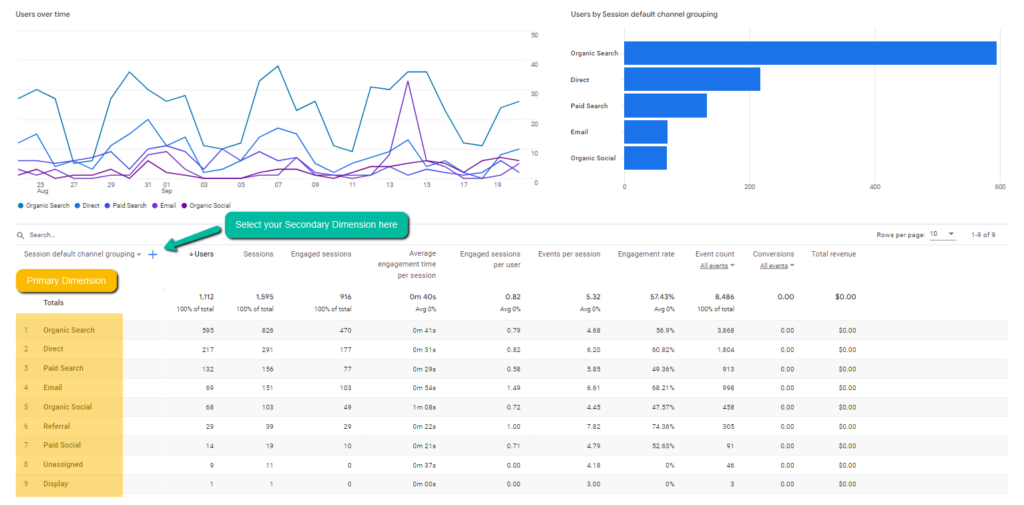Step-by-Step Guide: Leveraging Secondary Dimension in Google Analytics
Step-by-Step Guide: Leveraging Secondary Dimension in Google Analytics
Blog Article
Unlock Deeper Insights With Additional Dimension in Google Analytics
With the large area of data readily available in Google Analytics, the use of additional measurements can substantially enhance your analytical capabilities. These extra layers of data provide a nuanced viewpoint that can brighten elaborate details within your main metrics. By tactically integrating additional dimensions right into your analysis, you can uncover beneficial understandings that may or else continue to be obscure. The ability to interpret and dissect individual actions with higher accuracy opens a world of possibilities for maximizing methods and enhancing efficiency.
Understanding Primary Vs. Second Measurements
On the other hand, additional measurements permit you to more explore your key dimension data. By including a secondary measurement, you can layer on additional details to your main measurement, making it possible for an extra granular analysis. If your key dimension is the source/medium with which customers arrived on your site, including an additional measurement like geographic place can disclose where those individuals are situated geographically.
Utilizing Additional Dimensions Effectively
Effectively utilizing secondary measurements in Google Analytics enhances the deepness and granularity of data analysis, supplying important understandings into individual behavior and trends. By incorporating secondary measurements together with primary measurements, experts and online marketers can dig deeper into the specifics of individual communications on their web sites. Additional dimensions allow individuals to sector and filter key measurement data even more, supplying an extra comprehensive view of customer communications, demographics, and behaviors. This can be especially helpful when trying to recognize the influence of details variables on customer involvement, such as the internet browsers or tools they are using, the sources of their web traffic, or their geographic places.
Additionally, second dimensions make it possible for individuals to contrast and contrast different information points within a single record, promoting a much more detailed analysis of user actions patterns. By leveraging additional dimensions successfully, businesses can discover concealed understandings, maximize their advertising approaches, and enhance the general user experience on their websites.
Discovering Typical Additional Measurement Mixes
To additionally assess individual habits and fads in Google Analytics, it is beneficial to discover typical combinations of second measurements. By incorporating various second dimensions, marketing professionals and experts can gain deeper understandings into just how different aspects engage and affect site efficiency. Some common additional dimension mixes that offer valuable insights include evaluating traffic sources with user places to comprehend where website visitors are originating from geographically and how they located the website. Similarly, combining landing web pages with tools can reveal which pages execute best on various devices, assisting in maximizing the website for far better customer experience. Taking a look at individual habits metrics with second measurements such as passions or demographics can help in targeting specific target market sections more properly. By discovering these usual additional measurement combinations, companies can discover concealed patterns, recognize chances for improvement, and make data-driven decisions to improve their online presence.
Using Additional Measurement in Custom-made News
Using additional dimensions in custom-made records enables for a much more comprehensive evaluation of data in Google Analytics, enhancing the deepness of insights gotten. When producing custom records in Google Analytics, including secondary dimensions can offer an extra in-depth sight of how numerous measurements interact with each various other. This function makes it possible for customers to delve much deeper right into their information and discover valuable connections that may not be immediately noticeable.
By using secondary measurements in custom reports, individuals can obtain a far better understanding of their internet site or application web traffic. Incorporating the primary measurement of "source/medium" with the secondary measurement of "landing web page" can reveal which landing pages are performing best for web traffic coming from particular sources. check this This insight can aid marketing experts enhance their campaigns and boost overall conversion prices.

Enhancing Data Visualization With Additional Measurement
When checking out information in Google Analytics personalized reports, incorporating second measurements not just provides a much more detailed evaluation yet likewise enhances the graph of insights through information visualization. By adding an additional dimension to your records, you can enhance the way data exists, making it less complicated to recognize patterns, patterns, and relationships within your website's performance metrics.
Second measurements can assist you sector your information even more, allowing for a deeper understanding of user behavior and interactions on your site. When attempting to separate details variables that might influence your internet site's efficiency., this improved degree of granularity can be specifically beneficial.

Verdict
Finally, leveraging secondary dimensions in Google Analytics enables an extra thorough evaluation of data, resulting in much deeper understandings and more enlightened decision-making. Secondary Dimension in Google Analytics. By including extra layers of information to key information collections, experts and online marketers can discover surprise trends, patterns, and connections that offer a granular view of individual habits and interactions. This boosted level of understanding allows optimization of projects and customized methods for specific target market sections, inevitably boosting efficiency and conversion rates
On the other hand, secondary dimensions allow you to further explore your key measurement data. By including an additional dimension, you can layer on added information to your primary measurement, enabling a much more granular evaluation. If your key measurement is the source/medium with which individuals showed up on your site, adding a secondary measurement like geographic place can expose where those individuals are situated geographically. By incorporating second dimensions along with primary dimensions, analysts and online marketers can dig much deeper into the my sources specifics of individual interactions on their sites. Additional dimensions allow individuals to sector and filter key measurement information better, supplying a more detailed sight of customer behaviors, communications, and demographics.
Report this page